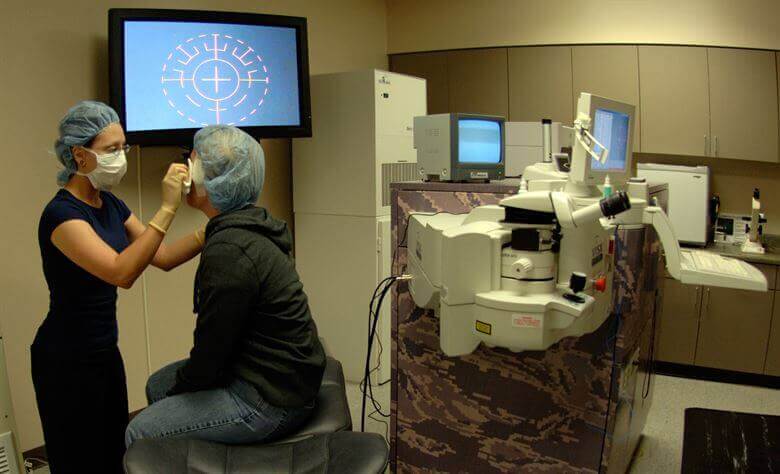There have been a few high-profile news reports regarding side effects and other LASIK risks. You might be wondering if those reports present an accurate picture of the procedure. Perhaps you’re considering whether LASIK might work for you and want to ensure that you’ll be safe undergoing a laser eye procedure.
Here, we’re going to examine the traits that make somebody a good LASIK candidate, and cover what sort of LASIK risks the procedure brings with it.
What’s your health like?
Any eye surgeon will examine your general health and your eye health before giving the green light for a laser procedure. Even if you have great eye health outside your nearsightedness or farsightedness, other health problems might increase the risk of certain procedures, and eye surgeons help plan around these factors. For instance:
- An immune system disorder that impairs your body’s natural healing or increases the chance of infection, like lupus or HIV, increases a patient’s LASIK risks.
- Regularly taking immunosuppressive medication can cause issues.
- Diabetes can increase the chance of certain side effects.
- Chronic pain from migraines, fibromyalgia, or irritable bowel syndrome might cause your eyes to be drier could exacerbate dry eye side effects. You might also experience additional post-op pain because of how you experience pain.
Is your vision stable?
Young individuals with myopia might experience changes in their vision through their teenage years or longer. For most teens, this means occasional changes in eyeglasses or contacts in order to match the new prescription.
Since the eye is still changing throughout this period, it’s best that patients are at least over the age of 18 before undergoing LASIK. Any other medications or conditions (like pregnancy) that causes a change in vision should also be completed before refractive surgery.
Potential LASIK risks, side effects, and complications.
Luckily, complications that result in a loss of vision are exceedingly rare. However, some side effects are very common. Many patients experience dry eye symptoms, and visual disturbances in the field of vision (like a halo) are also fairly common.
However, these symptoms resolve over the course of a few weeks or months. Very few patients have long-term issues with such side effects, but let’s take a detailed look at what sort of risks you can anticipate.
LASIK Risks #1: Dry Eyes
LASIK surgery can result in a decrease in tear production, and thus patients’ eyes are sometimes drier than usual. The reason this occurs is because corneal nerves are damaged during the procedure, and their ability to detect eye moisture is diminished.
Some patients experience this symptom even after the eye has superficially healed, as nerves take a bit longer to fully heal. The occasional patient has issues with dry eye even after healing, but there are ways to treat dry eye so that it doesn’t inconvenience you endlessly.
Most eye doctors recommend the use of special eye drops while your eyes are healing from a laser procedure. In the case of bad dry eye symptoms, ophthalmologists might choose to place small plugs inside the tear ducts.
These plugs prevent tears from draining out and away from the eye’s surface. While you might experience “tears” falling from your face from time to time, the extra moisture will guarantee that your eye stays healthy.
LASIK Risks #2: Visual Disturbances
Visual disturbances often manifest as glare, double vision, or halos. It’s not uncommon for patients to experience a decrease in night vision after a laser procedure. Halos might appear around bright lights, or you might catch some glare.
Such visual disturbances usually disappear after a few days or weeks have passed. If they seem to be sticking around, though, an eye surgeon might elect to do a second procedure and clear up those disturbances.
LASIK Risks #3: Over- and Undercorrections
The exact amount of tissue that needs to be removed isn’t always clear on a first procedure, especially if the patient suffers from severe near- or farsightedness. Undercorrections, which occur when too little of the cornea is removed, mean that the results are a little underwhelming, and your vision isn’t as clear as was promised.
Doctors might err on the side of caution, simply because this is a fixable problem. Another refractive surgery within the year can resolve the issue.
While uncommon, overcorrections can also occur. Overcorrections are difficult to solve with a procedure, since the issue is that too much of the cornea was shaved away. In such a situation, it’s likely that the best solution is external correction: eyeglasses or contact lenses.
LASIK Risks #4: Unexpected Healing
An uneven spread of tissue removal might generate astigmatism. Some cases of this injury-induced astigmatism can be solved by another procedure. But eyeglasses and contact lenses are always an option.
LASIK also involved creating a flap in the eye. And either folding it back or removing it to access the cornea. This has a chance of causing infection or the production of excess tears, and sometimes the top layer of skin can regrow abnormally over the flap and require a second procedure to get it to heal correctly.
Typical LASIK outcomes
Most LASIK patients attain good, even excellent, vision in most situations for decades after the procedure. Physical activities, like sports or swimming, can now be done glasses-free. While eyes still deteriorate with age. You can expect freedom from eyeglasses or contacts for many years after a laser procedure.
While LASIK has a great track record for patient satisfaction, few long-term results have been studied. Since initial responses are usually positive. It can be difficult to collect follow-up data on patients that have no reason to return.
LASIK technology and methods are always improving. Making long-term data on the newer, refined methods difficult to get a consensus on.

The final decision
There’s no perfect answer for those looking into LASIK. It’s best to approach this procedure as an informed patient. Knowing the risks and benefits, and deciding whether the procedure is right for you.
A consultation with an eye surgeon is an excellent first step, but don’t feel pressured. If your doctor is confident, and you’re confident, go for it! If not, don’t be afraid to back out. There’s usually another solution.























